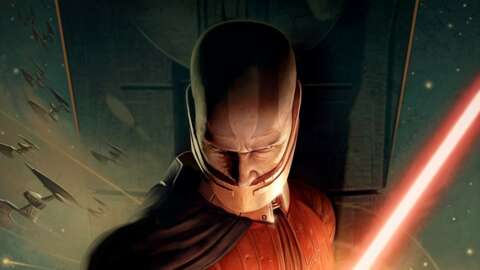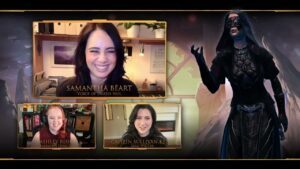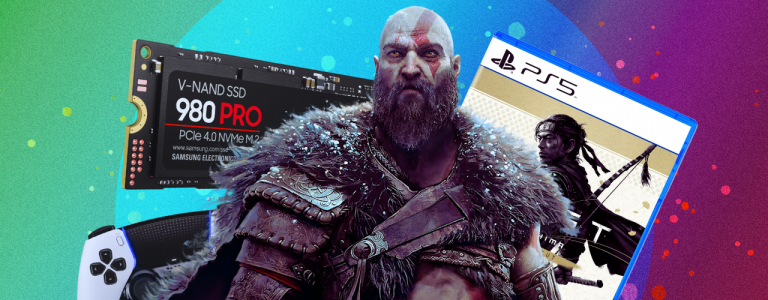
Star Wars: Knights of the Old Republic is celebrating its 20-year anniversary today, July 15, 2023. Below, we look at how it challenged and subverted some of Star Wars’ most common tropes.
Star Wars is obsessed with what machine and memory create, the blurred selves at the intersection of metal and flesh. Darth Vader is the clearest example of this. Anakin’s descent to the dark side renders itself real in his deformed body. Obi-Wan says that he is “more machine than man,” a fact that is leveraged in the stated impossibility of his redemption. Evil in Star Wars is associated with a disabled body, especially one that was once meat, muscle, and nerve, but is now wired with circuits.
Droids cannot be “force-sensitive” the way people can, and thus they don’t bear the moral weight of metal. But they are still seen as lesser. Droids provide slave labor and are owned by heroes and villains alike. A New Hope establishes within the first 20 minutes that droids’ memories are routinely wiped. Luke’s uncle Owen suggests it with the casualness of asking Luke to take out the trash. In the Star Wars universe, there is an entire class of people whose capacity to remember is entirely dependent upon the people who own them. Both inside and outside of its fiction, the perceived personhood of sentient beings relies on whether or not you are made of metal.
Gallery
Although much of Knights of the Old Republic’s narrative engine centers itself around simple binaries of good and evil, machine and man, it also prods at them. That might seem odd, as in retrospect, KOTOR feels like an attempt to get back to the good old days of Star Wars. In that way, it is distinctly un-subversive. It offers many of the same thrills and plot points as the original films. An evil empire rises that threatens an on-the-run group of resistance fighters. Your hero picks up two plucky robots: an astromech and a protocol droid. The climax involves destroying a powerful space station. Most famously, of course, the plot hinges on a twist about identity.
Still, KOTOR does play with the established formula. The game’s take on Han Solo is a teenage girl, its C-3P0 is not a queer-coded butler but an assassin robot obsessed with killing: the fan-favorite HK-47. Its twist of identity is not about heritage, but about self. The player’s own identity is revealed to be the memory-wiped Sith Lord Revan. Previously presumed dead, Revan was actually brainwashed by the Jedi, hoping that they could be the key to defeating the Sith Empire.
This twist has a decidedly queer character. Revan was a chosen name, separate from both Jedi and Sith until they turned to the dark side. Consider Revan’s mask, a device to make KOTOR’s twist possible, but also something that renders them formless, unable to be cleanly perceived, until the Jedi remove it. The game is unable to reckon with that “queer horror,” to borrow a phrase and framework. A light-side Revan doesn’t have room for feeling betrayed, nor a dark-side Revan motivation for anything but petty revenge. Revan’s choices are between re-assimilation into the system that rejected them or becoming the head of the space empire’s viper.
It’s hardly a compelling choice, as the difference between light and dark verges on the parodic. Physically threaten the shopkeeper for a lower price or don’t, barter a peace treaty with the Tusken Raiders or slaughter them all, pledge fealty to the Empire on Korriban, or stay loyal to the fractured Republic. However, buried in the game’s subtext, the difference between dark and light can feel slight. In one of many seeds for the game’s twist, one party member describes “Dark Jedi interrogation techniques” that “can wipe away your memories and destroy your very identity.” But it’s only the regular Jedi that actually use these methods in KOTOR’s story. Later, when companion Bastila is tortured into joining the dark side, her memory and sense of self remain intact. Still, both sides cruelly leverage power to reshape others, unafraid of bolstering their ranks with coercion.
The equivalence between dark and light is something it shares with the prequels. Both the stormtroopers (in A New Hope) and the Jedi (in The Phantom Menace) appear on Tatooine for their own arcane purposes and then disappear. Neither of them have any intention of freeing slaves. Mace Windu asserts that Jedi are not warriors; he leads battalions an hour and a half of movie runtime later. Binaries between flesh and metal are similarly questioned. Both clones and droids serve the same purpose: They are both manufactured, and they both die for their makers. Attack of the Clones offers one of the franchise’s most striking moments of visual poetry: The fleshy clones are made in an entirely cold and unnatural environment while battle droids are built in the heart of a mountain, encased in the earth.
Star Wars: Knights Of The Old Republic Remake Update | PlayStation Showcase 2021
Please use a html5 video capable browser to watch videos.
This video has an invalid file format.
Sorry, but you can’t access this content!
Please enter your date of birth to view this video
By clicking ‘enter’, you agree to GameSpot’s
Terms of Use and Privacy Policy
Even though Star Wars props up an ablest logic of personhood, it also relentlessly equivocates machine and man. In Return of the Jedi, Luke recognizes his father’s humanity in his severed, sparking hand, a robotic limb like his. In KOTOR, Revan restores HK-47’s memory just as they later reconstitute their own, though they never fully regain their memories. Revan’s mind is just as malleable as a droid’s. In a similar tack, both endings of KOTOR are basically the same, with Revan before a crowd, celebrating their victory. The primary difference is the colors of the flags flown and the music being played.
Lately, Star Wars has tended entirely towards the most conservative and restorative elements of its fantasy. The Mandolorian and The Book of Boba Fett lead on the same empty mythologizing and action figure posture. Even The Last Jedi, which prompted massive, misplaced ire and received somewhat outsized praise for its subversion, is ultimately affirming of the franchise’s mythic, but still consumerist, power. The movie ends with children playing out one of the film’s scenes with a handmade Luke Skywalker toy.
It’s easy to think of Star Wars as a great, glittering trap. The massiveness of its cultural import, the frequent sterility of its world, and its compromised but dogged insistence on easy binaries can make it feel enclosed. Imagining popular science fiction, whether it bears the Star Wars name or not, that actively questions and dismantles its assumptions feels impossible. Revan makes me long for it. I want a better world for them, for all of Star Wars’ machine men, where memory and selfhood are not conditional and cannot be stolen. But for Revan, like everyone else, there is only one fate: to play the part others give you and do what must be done.
The products discussed here were independently chosen by our editors.
GameSpot may get a share of the revenue if you buy anything featured on our site.






















